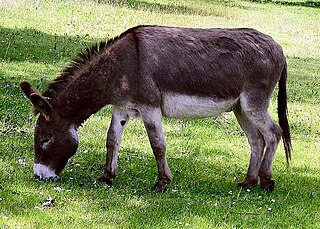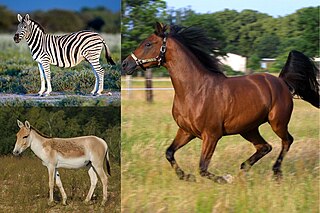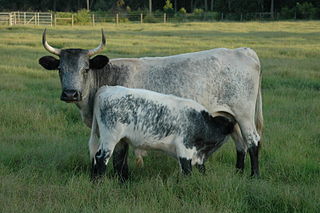A horse breed is a selectively bred population of domesticated horses, often with pedigrees recorded in a breed registry. However, the term is sometimes used in a broader sense to define landrace animals of a common phenotype located within a limited geographic region, or even feral "breeds" that are naturally selected. Depending on definition, hundreds of "breeds" exist today, developed for many different uses. Horse breeds are loosely divided into three categories based on general temperament: spirited "hot bloods" with speed and endurance; "cold bloods," such as draft horses and some ponies, suitable for slow, heavy work; and "warmbloods," developed from crosses between hot bloods and cold bloods, often focusing on creating breeds for specific riding purposes, particularly in Europe.

The donkey is a domesticated equine. It derives from the African wild ass, Equus africanus, and may be classified either as a subspecies thereof, Equus africanus asinus, or as a separate species, Equus asinus. It was domesticated in Africa some 5000–7000 years ago, and has been used mainly as a working animal since that time.

The mouflon is a wild sheep native to Cyprus, the Caspian region from eastern Turkey, Armenia, Azerbaijan, and Iran. It is thought to be the ancestor of all modern domestic sheep breeds.

The European fallow deer, also known as the common fallow deer or simply fallow deer, is a species of ruminant mammal belonging to the family Cervidae. It is historically native to Turkey and possibly the Italian Peninsula, Balkan Peninsula, and the island of Rhodes in Europe. Prehistorically native to and introduced into a larger portion of Europe, it has also been introduced to other regions in the world.

The Turkish Angora is a breed of domestic cat. Turkish Angoras are one of the ancient, natural breeds of cat, having originated in central Anatolia. The breed has been documented as early as the 17th century. Outside of the United States, the breed is usually referred to as simply the Angora or Ankara cat. These cats have slender and elegant bodies. In the winter they are perfectly camouflaged in the snow.

Equus is a genus of mammals in the family Equidae, which includes horses, asses, and zebras. Within the Equidae, Equus is the only recognized extant genus, comprising seven living species. Like Equidae more broadly, Equus has numerous extinct species known only from fossils. The genus most likely originated in North America and spread quickly to the Old World. Equines are odd-toed ungulates with slender legs, long heads, relatively long necks, manes, and long tails. All species are herbivorous, and mostly grazers, with simpler digestive systems than ruminants but able to subsist on lower-quality vegetation.
The Ponui or Ponui Island Donkey is a breed and feral population of domestic donkey from Ponui Island, in the Hauraki Gulf off New Zealand. It is the only feral donkey in New Zealand. It may also be called the New Zealand Donkey.

Ethiopian horses are those breeds or types of horse found in Ethiopia, formerly known as Abyssinia. There are about 2.8 million horses in Ethiopia, more than half the total in the African continent. Ethiopia reports only the Abyssinian breed to DAD-IS. In 2012 the horses of Ethiopia were characterised into eight distinct breeds or types with different regional distributions, including a gravely-endangered feral population, the Kundudo.

Aegean cats are a naturally occurring landrace of domestic cat originating from the Cycladic Islands of Greece and western Turkey. It is considered a natural cat, developing without human interference. Development of the Aegean cat as a formal breed began in the early 1990s by breeders in the fledgling Greek cat fancy, but the variety has yet to be recognized by any major fancier and breeder organization. It is considered to be the only native Greek variety of cat.

The Boreray, also known as the Boreray Blackface or Hebridean Blackface, is a breed of sheep originating on the St Kilda archipelago off the west coast of Scotland and surviving as a feral animal on one of the islands, Boreray. The breed was once reared for meat and wool, but is now used mainly for conservation grazing. The Boreray is one of the Northern European short-tailed sheep group of breeds.

The Baudet du Poitou, also called the Poitevin or Poitou donkey, is a French breed of donkey. It is one of the largest breeds, and jacks were bred to mares of the Poitevin horse breed to produce Poitevin mules, which were formerly in worldwide demand for agricultural and other work. The Baudet has a distinctive coat, which hangs in long, ungroomed locks or cadenettes.

The Florida Cracker or Florida Scrub is an American breed of cattle. It originated in Spanish Florida and later in the American state of Florida, and is named for the Florida cracker culture in which it was kept. It is one of the Criollo breeds that descend from the Spanish cattle originally brought to the Americas by the Spanish Conquistadors; among the other North American breeds in this group are the Pineywoods, the Corriente and Texas Longhorn. Unlike the Pineywoods – to which it is closely related – the Florida Cracker has not been inter-bred with breeds of North European origin.

The Asinara, Italian: Asino dell'Asinara, is a breed of feral donkey indigenous to the island of Asinara, which lies off the north-west coast of Sardinia, Italy, in the province of Sassari. Most of the population is wholly or partly albinistic; the small number of grey donkeys on the island are also considered part of the population, and may be heterozygous carriers of the albino gene. The Asinara is one of the eight autochthonous donkey breeds of limited distribution recognised by the Ministero delle Politiche Agricole Alimentari e Forestali, the Italian ministry of agriculture and forestry. It is called ainu, borricu or molenti in Sardinian.

The Balkan donkey or mountain donkey, Serbian: Domaći balkanski magarac, is a breed or group of breeds of domestic donkey originating in the Balkan region. It is reported from Serbia and Montenegro.

North American donkeys constitute approximately 0.1% of the worldwide donkey population. Donkeys were brought from Europe to the New World in the fifteenth century with the Second Voyage of Christopher Columbus, and subsequently spread into Mexico. They first reached what is now the United States in the late seventeenth century. Donkeys arrived in large numbers in the western United States during the gold rushes of the nineteenth century, as pack animals and for use in mines and ore-grinding mills. From about 1785, some large donkeys were imported from Europe to the eastern part of the continent.

Cyprus cats, also known as Cypriot cats, Saint Helen cats, and Saint Nicholas cats, are a landrace of domestic cat found across the island of Cyprus. A standardized breed is being developed from them; among cat fancier and breeder organizations, it is presently fully recognized by the World Cat Federation (WCF), with breeding regulated by the World Cat Congress (WCC), under the name Aphrodite's Giant; and provisionally by The International Cat Association (TICA) as the Aphrodite. All three organizations permit shorthaired and semi-longhaired versions and no out-crossing to other breeds.

The Pyrenean, French: Âne des Pyrénées, is a French breed of domestic donkey. It is distributed in a large area of south-western France, covering the whole of the regions of Aquitaine, Midi Pyrénées and Languedoc Roussillon. The largest concentration is in Aquitaine, which is a large part of the historic region of Gascony. The Pyrenean donkey breed unites two quite different types: the short and powerful Gascon type, and the taller and more elegant Catalan type, which is the French population of the Catalan donkey breed, approximately 20% of the total number of which is in the Roussillon.

The Asno de las Encartaciones, Basque: Enkarterriko asto, is a breed of small domestic donkey from the western part of the autonomous community of the Basque Country, in north-east Spain. It is named for the comarca of Las Encartaciones (Enkarterri), in the province of Biscay (Bizkaia). It is the only small donkey breed of Spain, and resembles the Gascon donkey, now a sub-type of the Pyrenean donkey. The Asno de las Encartaciones is critically endangered, and is protected by conservation measures.

The Corsican Donkey, French: Âne corse, Corsican: U sumeru corsu, is a breed of domestic donkey from the Mediterranean island of Corsica, a région and territorial collectivity of France. It is not recognised by the Ministère de l'agriculture, de l'agroalimentaire et de la forêt, the French ministry of agriculture, or by the Haras Nationaux, the French national stud; nor is it reported to the DAD-IS database of the FAO. Its numbers have fallen alarmingly; two associations are seeking its official recognition as a breed.

















